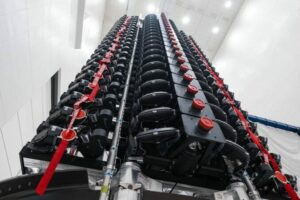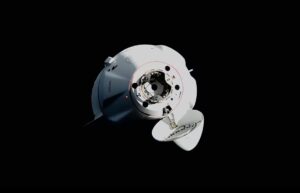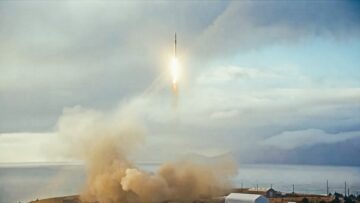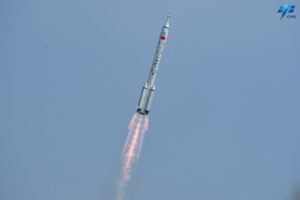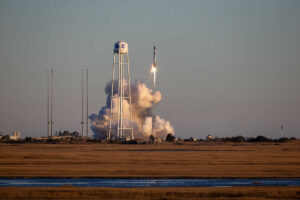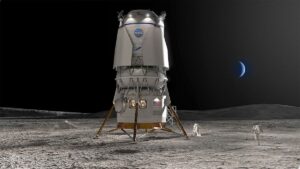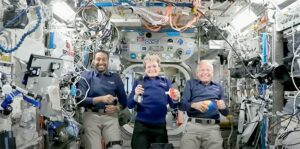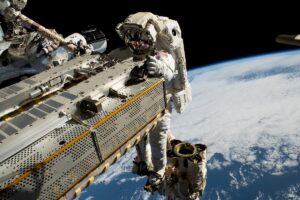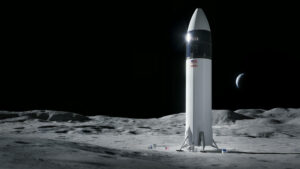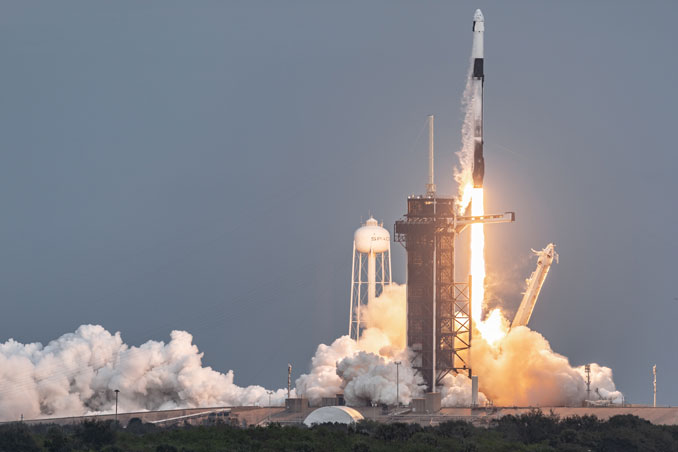
After months of training and detailed planning, the most international crew yet to visit the International Space Station blasted off atop a SpaceX Falcon 9 rocket Thursday to kick off a two-week research mission, the third fully commercial flight to the orbital outpost.
With retired NASA astronaut Michael López-Alegría and Italian co-pilot Walter Villadei at the controls, flanked by Turkish mission specialists Alper Gezeravci and Marcus Wandt of Sweden, the Falcon 9 thundered to life at 4:49 p.m. EST and climbed away from historic pad 39A at the Kennedy Space Center atop a brilliant jet of flaming exhaust.
The launch originally was planned for Wednesday, but SpaceX ordered a 24-hour delay, primarily to complete a review of work to address a potential issue with straps used to lessen the shock of parachute inflation during descent. The vehicle then was cleared for flight.
Rocketing away along a trajectory paralleling the East Coast of the United States, the 12-minute climb to space got off to a picture-perfect start, thrilling area residents and tourists with a late-afternoon sky show despite low clouds that limited the view.
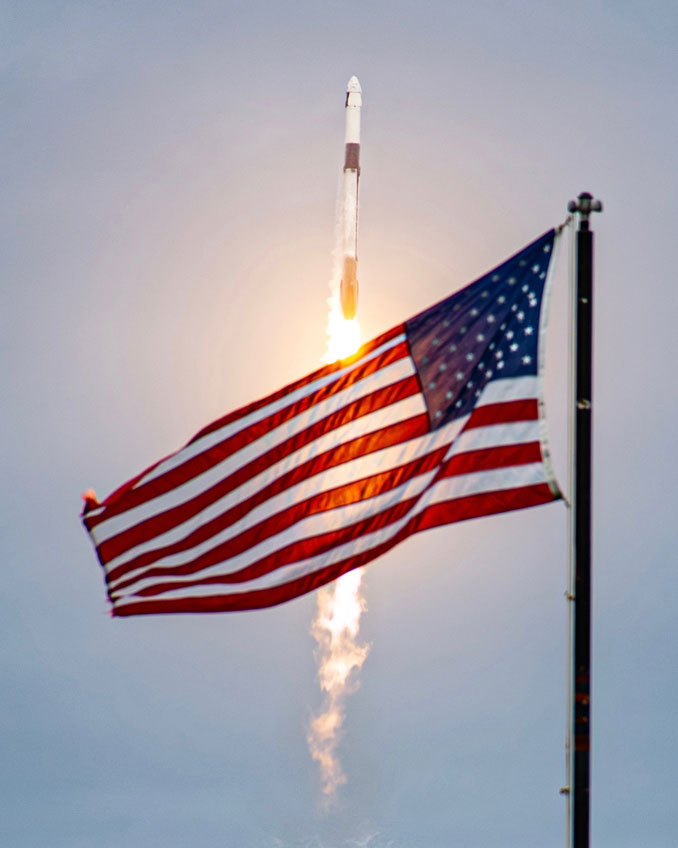
Adding to the spectacle, the booster’s first stage, heralded by twin sonic booms, flew itself back to a rocket-powered landing at the Cape Canaveral Space Force Station, chalking up SpaceX’s 43rd landing in Florida and its 265th overall.
A few minutes later, the Crew Dragon capsule was released to fly on its own. SpaceX Chief Engineer Bill Gerstenmaier radioed congratulations to the crew “on a great ride to orbit. I think you’re demonstrating the ultimate in reuse — a reused commander, reused Dragon and a reused Falcon. Or maybe ‘flight experienced’ is a better word. Enjoy space.”
“It’s a team sport. Thank you guys,” López-Alegría replied. The SpaceX flight director then chimed in, welcoming the first-time fliers to orbit. “Mike, on the other hand, welcome to the Dragon frequent-flier club. I imagine you’ll have enough miles to qualify for platinum status after this flight.”
If all goes well, López-Alegría and Villadei will monitor an automated approach to the space station, catching up from behind and below to set up a docking at the lab’s forward port early Saturday.
They’ll be welcomed aboard by the station’s current seven-member crew: Soyuz MS-24/70S commander Oleg Kononenko and his two crewmates, Nikolai Chub and NASA astronaut Loral O’Hara, along with NASA Crew-7 commander Jasmin Moghbeli, European Space Agency astronaut Andreas Mogensen, Japanese flier Satoshi Furukawa and cosmonaut Konstantin Borisov.
One of America’s most experienced astronauts, López-Alegría, 65, holds dual U.S.-Spanish citizenship and is a veteran of five previous spaceflights and 10 spacewalks. Now chief astronaut at Houston-based Axiom Space, he commanded the company’s first commercial flight to the ISS — Ax-1 — in 2022.
Asked if he has any plans to hang up his spacesuit after the Ax-3 mission, López-Alegría smiled and said he’ll fly as long as he’s allowed.
“It’s a dream come true for me,” he told CBS News. “I will gladly continue to fly as long as the soul is willing, as long as the body is willing to do so. But seriously, this is really a privilege for somebody in my position to be able to go back to space, first of all, but especially to lead this very well-prepared and expertly trained group. It never gets old.”
During their stay aboard the station, the Ax-3 crew will carry out more than 30 microgravity experiments, most supplied by Italy, to learn more about the effects of weightlessness on a variety of physical and cognitive parameters.
In a lighter vein, the Italian company Barilla has provided ready-made pasta that will be heated up and taste tested “as part of an effort to develop a broader range of tasty foods in space for future space travelers,” according to Axiom.
Other research includes ways to use telemedicine to evaluate the health of astronauts in space, tests of a “smart flight suit” designed to “increase the psycho-physical comfort of the astronaut and to monitor medical data” and another project to test materials better able to shield astronauts from space radiation.
Once the experiments are complete, López-Alegría and his crewmates will strap back into their Crew Dragon and undock from the space station on Feb. 3 for a fiery plunge back to Earth and splashdown off the coast of Florida.
The Axiom flights are sanctioned by NASA, which is trying to encourage private-sector development in low-Earth orbit. The company is using the “private astronaut missions,” or PAMs, to gain experience with orbital operations before launching its own space station modules later this decade.
Neither SpaceX nor Axiom will say how much the Ax-3 flight cost or how much Italy, Sweden and Turkey might have paid to put their representatives on board. But commercial seats are thought to cost well above $50 million each.
Axiom’s first two PAM missions featured a mix of private citizens and state-sponsored researchers, including two Saudis. For the third flight, all three passengers are sponsored by their respective countries.
Villadei, 49, is a father of three with a master’s in aerospace engineering and a veteran Italian air force flight engineer. Last June, he completed an up-and-down sub-orbital flight aboard Virgin Galactic’s Unity spaceplane to carry out Italian-sponsored microgravity research. Ax-3 is his first trip to orbit.
“This mission is very important for Italy,” he said. “It’s a fundamental step in our national space strategy. It’s a big opportunity for bringing industries, the scientific community (together) in this new chapter of the space exploration, which is commercial space flight. I can’t wait to make and implement the experiments that have been provided. It’s a huge opportunity.”
Gezeravci, 44, is a veteran Turkish F-16 fighter pilot and wing commander who spent seven years as a Turkish Airlines captain. He will become Turkey’s first astronaut.
“I am representing my beautiful country, Turkey, as the first person to go to space,” he said. “This mission is not only the Earth man mission, but it’s also representing a lot of scientific missions that we are intending to contribute in the science world.”
Wandt, 43, is a father of three with a master’s in electrical engineering who is a veteran fighter pilot, a graduate of the U.S. Naval Test Pilot School and a member of the European Space Agency’s astronaut corps, the first to fly on a commercial mission. He also founded a company that helps train fighter pilots.
“I’m so proud to (be) a part of pioneering a new way for Europe to gain access to space and to increase the frequency and the presence of not only a European presence, but also European science.”
Axiom Space, is developing a module that will be attached to the International Space Station in the next few years to serve as a precursor to a stand-alone commercial space station.
López-Alegría’s Ax-3 mission, like the Ax-1 and Ax-2 flights before it, is seen as a critical step toward developing Axiom’s private-sector space station, an outpost that can be used by government and private astronauts and researchers alike after the International Space Station is retired at the end of the decade.
“These are what we call precursor missions,” said López-Alegría. “So the idea is for us to establish the processes and the organizations operationally within the company to be able to sustain human spaceflight missions.
“We want that commercial space station to be a destination not only for the users of the ISS today, but also many more people, researchers, countries around the world.”
- SEO Powered Content & PR Distribution. Get Amplified Today.
- PlatoData.Network Vertical Generative Ai. Empower Yourself. Access Here.
- PlatoAiStream. Web3 Intelligence. Knowledge Amplified. Access Here.
- PlatoESG. Carbon, CleanTech, Energy, Environment, Solar, Waste Management. Access Here.
- PlatoHealth. Biotech and Clinical Trials Intelligence. Access Here.
- Source: https://spaceflightnow.com/2024/01/18/falcon-9-boosts-axiom-crew-into-space-for-commercial-visit-to-iss/
- :has
- :is
- :not
- ][p
- $UP
- 10
- 2022
- 30
- 43
- 49
- 65
- 678
- 9
- a
- Able
- About
- above
- access
- According
- Adam
- address
- Aerospace
- aerospace engineering
- After
- agency
- AIR
- Air Force
- Airlines
- alike
- All
- allowed
- along
- also
- am
- an
- and
- Another
- any
- approach
- ARE
- AREA
- around
- AS
- astronaut
- At
- Automated
- away
- back
- BE
- beautiful
- become
- been
- before
- behind
- below
- Better
- Big
- Bill
- board
- body
- boosts
- brilliant
- Bringing
- broader
- but
- by
- call
- CAN
- cape
- carry
- carrying
- Center
- Chapter
- chief
- Citizens
- climb
- Climbed
- club
- Coast
- cognitive
- come
- comfort
- commercial
- community
- company
- Company’s
- complete
- Completed
- continue
- contribute
- controls
- Cost
- countries
- country
- crew
- critical
- Current
- decade
- delay
- demonstrating
- designed
- Despite
- destination
- detailed
- develop
- developing
- Development
- Director
- do
- Dragon
- dream
- dual
- during
- each
- Early
- earth
- East
- east coast
- effects
- effort
- electrical engineering
- encourage
- end
- engineer
- Engineering
- enjoy
- enough
- especially
- establish
- Europe
- European
- European Space Agency
- evaluate
- experience
- experienced
- experiments
- expertly
- exploration
- falcon
- Falcon 9
- featured
- Feb
- few
- First
- five
- flight
- Flights
- florida
- foods
- For
- Force
- Forward
- Founded
- Frequency
- from
- fully
- fundamental
- future
- Gain
- gladly
- Go
- Goes
- got
- Government
- graduate
- great
- Group
- hand
- Hang
- Have
- he
- Health
- helps
- High
- his
- historic
- holds
- How
- http
- HTTPS
- huge
- human
- i
- idea
- if
- image
- imagine
- implement
- important
- in
- includes
- Including
- Increase
- industries
- inflation
- Intending
- International
- international space station
- into
- ISS
- issue
- IT
- Italian
- Italy
- ITS
- itself
- Japanese
- jpg
- june
- kick
- landing
- Last
- later
- launch
- launching
- lead
- LEARN
- Life
- lighter
- like
- Limited
- Long
- Lot
- Low
- make
- man
- many
- Marcus
- master’s
- materials
- max-width
- maybe
- me
- medical
- member
- Michael
- might
- million
- minutes
- Mission
- missions
- mix
- module
- Modules
- Monitor
- months
- more
- most
- much
- my
- Nasa
- National
- never
- New
- news
- next
- nor
- now
- of
- off
- Old
- on
- only
- Operations
- Opportunity
- or
- Orbit
- organizations
- originally
- Other
- our
- out
- overall
- own
- pad
- paid
- parameters
- part
- People
- person
- physical
- pilot
- Pilots
- Pioneering
- planned
- planning
- plans
- platinum
- plato
- Plato Data Intelligence
- PlatoData
- plunge
- position
- potential
- precursor
- presence
- press
- previous
- primarily
- private
- privilege
- processes
- project
- proud
- provided
- put
- qualify
- Radiation
- range
- ready-made
- really
- released
- Representatives
- representing
- research
- researchers
- residents
- respective
- reuse
- review
- Ride
- rocket
- s
- Said
- Sanctioned
- Satoshi
- saturday
- say
- School
- Science
- scientific
- seen
- seriously
- serve
- set
- seven
- Shield
- show
- site
- sky
- So
- Soul
- Space
- space exploration
- Space Force
- space station
- spaceflight
- SpaceX
- specialists
- spent
- Sponsored
- Sport
- Stage
- start
- States
- station
- Status
- stay
- Step
- Strategy
- supplied
- Sweden
- taste
- team
- telemedicine
- test
- tested
- tests
- than
- thank
- that
- The
- the world
- their
- then
- think
- Third
- this
- thought
- three
- thrilling
- thursday
- to
- today
- together
- told
- toward
- Train
- trained
- Training
- trajectory
- travelers
- trip
- true
- trying
- Turkey
- Turkish
- twin
- two
- u.s.
- ultimate
- United
- United States
- unity
- us
- use
- used
- users
- using
- variety
- vehicle
- very
- veteran
- View
- Virgin
- Visit
- wait
- want
- was
- Way..
- ways
- we
- Wednesday
- welcome
- welcomed
- welcoming
- WELL
- What
- which
- WHO
- will
- willing
- Wing
- with
- within
- Word
- Work
- world
- years
- yet
- you
- zephyrnet

